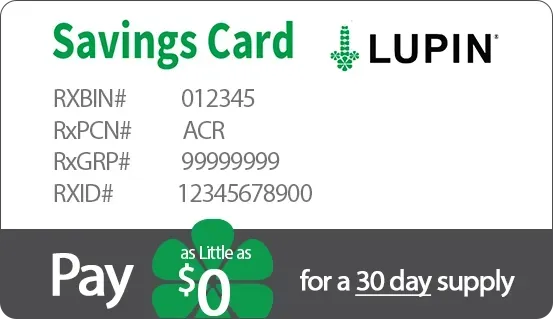
Glycerol Phenylbutyrate Oral Liquid
*All registered trademarks are the property of their respective owners. These products are intended for U.S. residents only.
GLYCEROL PHENYLBUTYRATE ORAL LIQUID
A generic equivalent to RAVICTI®*
RAVICTI® is a registered trademark of Horizon Therapeutics U.S. Holding LLC
- For people of all ages with urea cycle disorders
(UCDs), from newborns to adults - A clear liquid, taken by mouth
What is Glycerol Phenylbutyrate Oral Liquid?
Glycerol Phenylbutyrate Oral Liquid is a prescription medicine used for long-term management of high blood levels of ammonia (hyperammonemia) caused by a condition called a urea cycle disorder (UCD).
Glycerol Phenylbutyrate Oral Liquid should be used if the Urea Cycle Disease cannot be managed with a low- protein diet and dietary supplements alone. Glycerol Phenylbutyrate Oral Liquid must be used along with a low- protein diet and in some cases dietary supplements.
Glycerol Phenylbutyrate Oral Liquid is not used for the acute treatment of hyperammonemia in people with UCD.
It is not known if Glycerol Phenylbutyrate Oral Liquid is safe and effective for the treatment of N-acetylglutamate synthase (NAGS) deficiency.

About Glycerol Phenylbutyrate Oral Liquid
Some people with UCD can't manage their elevated ammonia levels with a low-protein diet and supplements alone.
To help control ammonia levels, these people may be prescribed a nitrogen-scavenger medicine (which can also be called an ammonia scavenger supplement). Glycerol Phenylbutyrate Oral Liquid is an ammonia scavenger that must be used along with a low-protein diet that may include supplements.
Glycerol Phenylbutyrate Oral Liquid helps manage ammonia levels for newborns, babies, children, and adults with UCDs.

Glycerol Phenylbutyrate Oral Liquid is a clear liquid medication that can be taken by mouth as little as three times per day.
Tips for Taking Your Glycerol Phenylbutyrate Oral Liquid

Do
- Take by mouth using the oral syringe provided with the product
- Take three times per day or more
- Take with food
- Use a new, dry oral syringe every day
- Dispose of the used oral syringe after the last dose of the day
- Discard bottle and any remaining contents 28 days after opening

Don't
- Take 2 doses of Glycerol Phenylbutyrate Oral Liquid at one time
- Take more Glycerol Phenylbutyrate Oral Liquid than your doctor has instructed
(If you take too much Glycerol Phenylbutyrate Oral Liquid, call your doctor or your poison control center at 1-800-222-1222 or go to the nearest hospital emergency room right away) - Take Glycerol Phenylbutyrate Oral Liquid that has come into contact with water or is cloudy
- Stop taking Glycerol Phenylbutyrate Oral Liquid unless your doctor tells you to stop
Step-by-Step Guide to Using the Bottle and Oral Syringe
When dosing Glycerol Phenylbutyrate Oral Liquid, be sure to use the oral syringe provided with the product. Ask your pharmacist for oral syringes and a reclosable bottle cap adapter for each bottle you receive if you do not have them.
Use the Glycerol Phenylbutyrate Oral Liquid bottle and oral syringe as follows:
- Use a new reclosable bottle cap adapter with each new Glycerol Phenylbutyrate Oral Liquid bottle that is opened.
- Open the Glycerol Phenylbutyrate Oral Liquid bottle and twist on the new reclosable bottle cap adapter.
- Use a new dry oral syringe to remove each prescribed dose of Glycerol Phenylbutyrate Oral Liquid.
- Throw away (discard) the oral syringe after each dose.
- Tightly close the tethered tab on the reclosable bottle cap adapter after each use.
- Do not rinse the reclosable bottle cap adapter.
- If water or moisture enters the Glycerol Phenylbutyrate Oral Liquid bottle, the contents will become cloudy in appearance. If the contents appear cloudy at any time, do not use the remaining Glycerol Phenylbutyrate Oral Liquid and return the bottle to your pharmacy to throw it away.
- Throw away the bottle and any unused Glycerol Phenylbutyrate Oral Liquid 28 days after opening.
Additional Information for Adults and Children 2 Years of Age and Older:
- Not able to take Glycerol Phenylbutyrate Oral Liquid by mouth? Glycerol Phenylbutyrate Oral Liquid can also be taken by feeding tube or gastrostomy tube (G-tube). If you have a G-tube but can swallow safely, you can still take Glycerol Phenylbutyrate Oral Liquid by mouth.
- Glycerol Phenylbutyrate Oral Liquid can be taken by adults and children 2 years of age and older as few as 3 times per day. Your doctor will tell you how Often to take Glycerol Phenylbutyrate Oral Liquid.
Additional Information for Newborns, Babies, and Toddlers up to 2 Years of Age:
- Give newborns, babies, and toddlers up to 2 years of age 3 or more equal doses of Glycerol Phenylbutyrate Oral Liquid each day with food or formula.
- Glycerol Phenylbutyrate Oral Liquid can also be administered to newborns, babies, and toddlers by feeding tube or gastrostomy tube (G-tube).
- Breastfeeding infants should be given Glycerol Phenylbutyrate Oral Liquid immediately prior to breastfeeding.
- Remember: people who take Glycerol Phenylbutyrate Oral Liquid must also follow a low-protein diet, and in some cases, take dietary supplements (as directed by a doctor).

Frequently Asked Questions
How many times per day should I take or administer Glycerol Phenylbutyrate Oral Liquid?
Glycerol Phenylbutyrate Oral Liquid can be taken by adults and children 2 years of age and older as few as 3 times per day. Your doctor will tell you how often to take Glycerol Phenylbutyrate Oral Liquid.
Give newborns, babies, and toddlers up to 2 years of age 3 or more equal doses of Glycerol Phenylbutyrate Oral Liquid each day with food or formula.
What if the person taking Glycerol Phenylbutyrate Oral Liquid has a feeding tube or G-tube?
Glycerol Phenylbutyrate Oral Liquid can also be taken by feeding tube or gastrostomy tube (G-tube). If you have a G-tube but can swallow safely, you can still take Glycerol Phenylbutyrate Oral Liquid by mouth.
Glycerol Phenylbutyrate Oral Liquid can also be administered to newborns, babies, and toddlers by feeding tube or gastrostomy tube (G-tube).
How to take with a feeding tube or G-tube: Use a new dry oral syringe to withdraw each prescribed dose of Glycerol Phenylbutyrate Oral Liquid from the bottle. Place the tip of the syringe into the nasogastric or gastrostomy tube and push the plunger of the syringe to give Glycerol Phenylbutyrate Oral Liquid into the tube. Use a separate syringe to flush the nasogastric or gastrostomy tube. Add 10 mL of water or formula to the syringe and push the plunger of the syringe to flush any remaining medicine from the nasogastric or gastrostomy tube into the stomach. If needed, flush the nasogastric or gastrostomy tube again with 10 mL of water or formula to clear the nasogastric or gastrostomy tube.
What if I'm administering Glycerol Phenylbutyrate Oral Liquid to a breastfeeding infant?
Breastfeeding infants should be given Glycerol Phenylbutyrate Oral Liquid immediately prior to breastfeeding.
What should I do if I forget a dose of Glycerol Phenylbutyrate Oral Liquid?
If you miss a dose of Glycerol Phenylbutyrate Oral Liquid, take it as soon as possible. Do not take 2 doses of Glycerol Phenylbutyrate Oral Liquid at the same time. If you miss more than 1 dose and are not feeling well, call your doctor or nurse right away.
What if my Glycerol Phenylbutyrate Oral Liquid starts to look cloudy?
If your bottle of Glycerol Phenylbutyrate Oral Liquid looks cloudy, do not use the remaining Glycerol Phenylbutyrate Oral Liquid in the bottle and return it to the pharmacy to be discarded.
Is there a copay savings card for Glycerol Phenylbutyrate Oral Liquid?
Yes, a savings card is available for download here.
For additional savings while on treatment, use your copay savings card to lower your out-of-pocket costs at the Specialty Pharmacy.

USE AND IMPORTANT SAFETY INFORMATION
What is the most important safety information I should know about Glycerol Phenylbutyrate Oral Liquid?
Glycerol phenylbutyrate oral liquid may cause serious side effects, including:
Nervous system side effects (Neurotoxicity) Phenylacetate (PAA), a breakdown product of glycerol phenylbutyrate oral liquid, may cause nervous system side effects. Call your doctor or get medical help right away if you have any Of these symptoms while taking glycerol phenylbutyrate oral liquid:
sleepiness
lightheadedness
change in taste
problems with hearing
confusion
problems with memory
worsening of numbness, tingling, or burning in your hands or feet
headache
feeling very tired (fatigue)
nausea
vomiting
Your doctor may do blood tests to measure the amount of PAA in your blood during your treatment with glycerol phenylbutyrate oral liquid.
What is Glycerol Phenylbutyrate Oral Liquid?
Glycerol phenylbutyrate oral liquid is a prescription medicine used for long-term management of high blood levels of ammonia (hyperammonemia) caused by a condition called a urea cycle disorder (UCD). Glycerol phenylbutyrate oral liquid should be used if the UCD cannot be managed with a low-protein diet and dietary supplements alone. Glycerol phenylbutyrate oral liquid must be used along with a low-protein diet and in some cases dietary supplements.
Glycerol phenylbutyrate oral liquid is not used for the acute treatment of hyperammonemia in people with UCDs.
It is not known if glycerol phenylbutyrate oral liquid is safe and effective for the treatment of N-acetylglutamate synthase (NAGS) deficiency. Do not take glycerol phenylbutyrate oral liquid if you are allergic to phenylbutyrate.
Call your doctor or go to the nearest hospital emergency room if you have wheezing, shortness of breath, cough, low blood pressure, flushing, nausea or a rash while taking glycerol phenylbutyrate oral liquid.
Do not take glycerol phenylbutyrate oral liquid if you are allergic to phenylbutyrate.
Before taking glycerol phenylbutyrate oral liquid tell your doctor about all of your medical conditions, including if you:
have liver or kidney problems.
have pancreas or bowel (intestine) problems.
are pregnant or plan to become pregnant. It is not known if glycerol phenylbutyrate oral liquid will harm your unborn baby. If you become pregnant during treatment with glycerol phenylbutyrate oral liquid, call Horizon at 1-800-772-6436 to report the pregnancy.
are breastfeeding or plan to breastfeed. It is not known if glycerol phenylbutyrate passes into your breast milk. Breastfeeding is not recommended during treatment with glycerol phenylbutyrate oral liquid. Talk to your doctor about the best way to feed your baby if you take glycerol phenylbutyrate oral liquid.
What are possible side effects of Glycerol Phenylbutyrate Oral Liquid?
Glycerol phenylbutyrate oral liquid may cause serious side effects, including:
See "What is the most important information I should know about Glycerol Phenylbutyrate Oral Liquid?"
The most common side effects of glycerol phenylbutyrate oral liquid in adults include:
diarrhea
gas
headache
abdomen (stomach) pain
vomiting
tiredness
decreased appetite
indigestion or heartburn
The most common side effects of glycerol phenylbutyrate oral liquid in children 2 years to 17 years of age include:
upper abdomen (stomach) pain
rash
nausea
vomiting
diarrhea
decreased appetite
headache
The most common side effects of glycerol phenylbutyrate oral liquid in children 2 months to less than 2 years of age include:
low white blood cell count (neutropenia)
vomiting
constipation
diarrhea
fever
reduced food intake
cough
stuffy nose
runny nose
skin rash
small round bumps on the skin
The most common side effects of glycerol phenylbutyrate oral liquid in children less than 2 months of age include:
vomiting
rash
gastroesophageal reflux
increased levels of liver enzymes in the blood
decreased appetite and reduced food intake
low red blood cell count (anemia)
cough
loss of too much body fluid (dehydration)
too much acid in the blood (acidosis)
high blood platelet count (thrombocytosis)
low blood platelet count (thrombocytopenia)
low blood neutrophil count (type of white blood cell) (neutropenia)
high blood white blood cell count (lymphocytosis)
diarrhea
gas
constipation
fever
drowsiness (lethargy)
irritability
agitation
These are not all of the possible side effects of glycerol phenylbutyrate oral liquid. Call your doctor for medical advice about side effects. You may report side effects to FDA at 1-800-FDA-1088 or Horizon at 1-800-772-6436.
For additional Important Safety Information, click here for the MEDICATION GUIDE and discuss with your doctor.
PP-GLP-OOOI
©2025 Lupin Pharmaceuticals, Inc.
GLYCEROL PHENYLBUTYRATE ORAL LIQUID
Therapeutically equivalent to RAVICTI®*
RAVICTI® is a registered trademark Horizon Therapeutics U.S. Holding LLC
- A generic option for patients with urea cycle
disorders (UCDs)
Indication
Glycerol Phenylbutyrate Oral Liquid is indicated for use as a nitrogen-binding agent for chronic management of
patients with urea cycle disorders (UCDs) who cannot be managed by dietary protein restriction and/or
supplementation alone. Glycerol Phenylbutyrate Oral Liquid must be used with dietary protein restriction and, in
some cases, dietary supplements (e.g. essential amino acids, arginine, citrulline, protein-free calorie
supplements).


For patients 2 years of age and older:
Give Glycerol Phenylbutyrate Oral Liquid in 3 equally divided dosages, each rounded up to the nearest 0.5 mL.
For patients less than 2 years:
Give Glycerol Phenylbutyrate Oral Liquid in 3 or more equally divided dosages, each rounded up to the nearest 0.1 mL.
The maximum total daily dosage is 17.5 mL (19 g).
Glycerol Phenylbutyrate Oral Liquid must be used with dietary protein restriction and, in some cases, dietary supplements (e.g., essential amino acids, arginine, citrulline, protein-free calorie supplements).
Initial Dosage for Phenylbutyrate-Naive Patients
The recommended dosage range, based upon body surface area (BSA), in patients naive to phenylbutyrate (PBA) is 4.5 to 11.2 mL/m²/day (5 to 12.4 g/m²/day). For patients with some residual enzyme activity who are not adequately controlled with protein restriction, the recommended starting dosage is 4.5 mL/m²/day.
In determining the starting dosage of Glycerol Phenylbutyrate Oral Liquid in treatment-naive patients, consider the patient's residual urea synthetic capacity, dietary protein requirements, and diet adherence. Dietary protein is approximately 16% nitrogen by weight. Given that approximately 47% of dietary nitrogen is excreted as waste and approximately 70% of an administered PBA dose will be converted to urinary phenylacetylglutamine (U-PAGN), an initial estimated Glycerol Phenylbutyrate Oral Liquid dose I for a 24-hour period is 0.6 mL Glycerol Phenylbutyrate Oral Liquid per gram of dietary protein ingested per 24-hour period.
The total daily dosage for phenylbutyrate naive patients should not exceed 17.5 mL.
Dosage for Patients Switching from Sodium Phenylbutyrate to Glycerol Phenylbutyrate Oral Liquid
Patients switching from sodium phenylbutyrate supplement to Glycerol Phenylbutyrate Oral Liquid should receive the dosage of Glycerol Phenylbutyrate Oral Liquid that contains the same amount of phenylbutyric acid.
The conversion is as follows:
Total daily dosage of Glycerol Phenylbutyrate Oral Liquid (mL) = total daily dosage of sodium phenylbutyrate tablets (g) x 0.86
Total daily dosage of Glycerol Phenylbutyrate Oral Liquid (mL) = total daily dosage of sodium phenylbutyrate powder (g) x 0.81
Administration of Glycerol Phenylbutyrate Oral Liquid
Instruct patients to take Glycerol Phenylbutyrate Oral Liquid as follows:
Step-by-Step Guide to Using the Bottle and Oral Syringe
Instruct patients that when dosing Glycerol Phenylbutyrate Oral Liquid, they should be sure to use the oral syringe provided with the product. They should ask their pharmacist for oral syringes and a reclosable bottle cap adapter for each bottle they receive if they do not have them
The Glycerol Phenylbutyrate Oral Liquid bottle and oral syringe should be used as follows:
- Use a new reclosable bottle cap adapter with each new Glycerol Phenylbutyrate Oral Liquid bottle that is opened.
- Open the Glycerol Phenylbutyrate Oral Liquid bottle and twist on the new reclosable bottle cap adapter.
- Use a new dry oral syringe to remove each prescribed dose of Glycerol Phenylbutyrate Oral Liquid.
- Throw away (discard) the oral syringe after each dose.
- Tightly close the tethered tab on the reclosable bottle cap adapter after each use.
- Do not rinse the reclosable bottle cap adapter.
- If water or moisture enters the Glycerol Phenylbutyrate Oral Liquid bottle, the contents will become cloudy in appearance. If the contents appear cloudy at any time, do not use the remaining Glycerol Phenylbutyrate Oral Liquid and return the bottle to your pharmacy to throw it away.
- Throw away the bottle and any unused Glycerol Phenylbutyrate Oral Liquid 28 days after opening.

Frequently Asked Questions
Can my patients with a feeding tube or G-tube take Glycerol Phenylbutyrate Oral Liquid?
Yes, patients with feeding tubes or g-tubes can take Glycerol Phenylbutyrate Oral Liquid, administered through the tubing. Refer to the Prescribing Information, Dosage and Administration section 2.6 for administration guidelines.
For patients who require a volume of less than 1 mL per dose via nasogastric or gastrostomy tube, the delivered dose may be less than anticipated. Closely monitor these patients using ammonia levels.
Can patients switch from Sodium Phenylbutyrate to Glycerol Phenylbutyrate Oral Liquid?
Yes, patients can switch to Glycerol Phenylbutyrate Oral Liquid with a dosage adjustment. See the dosing conversion for patients who have previously taken Sodium Phenylbutyrate.
Is a savings card available for Glycerol Phenylbutyrate Oral Liquid?
Yes, eligible patients can save on their prescription with the copay savings card from Lupin Pharmaceuticals. Download it here. Terms and conditions apply.
Is Glycerol Phenylbutyrate Oral Liquid therapeutically equivalent to RAVICTI?
Yes, Glycerol Phenylbutyrate Oral Liquid is an FDA-approved generic medication for RAVICTI.
For additional savings while on treatment, offer your patients this copay savings card to help lower their out-of-pocket costs at the Specialty Pharmacy.


INDICATION
Glycerol phenylbutyrate oral liquid is indicated for use as a nitrogen-binding agent for chronic management of patients with urea cycle disorders (UCDs) who cannot be managed by dietary protein restriction and/or amino acid supplementation alone. Glycerol phenylbutyrate oral liquid must be used with dietary protein restriction and, in some cases, dietary supplements (e.g. essential amino acids, arginine, citrulline, protein-free calorie supplements).
LIMITATIONS OF USE
Glycerol phenylbutyrate oral liquid is not indicated for the treatment of acute hyperammonemia in patients with UCDs because more rapidly acting interventions are essential to reduce plasma ammonia levels.
The safety and efficacy of glycerol phenylbutyrate oral liquid for the treatment of N-acetylglutamate synthase (NAGS) deficiency has not been established.
IMPORTANT SAFETY INFORMATION
CONTRAINDICATIONS
Patients with known hypersensitivity to phenylbutyrate: Reactions include wheezing, dyspnea, coughing, hypotension, flushing, nausea, and rash.
WARNINGS AND PRECAUTIONS
Neurotoxicity: Phenylacetate (PAA), the major metabolite of glycerol phenylbutyrate, may be toxic at levels of 500 micrograms/mL or greater. If symptoms of vomiting, nausea, headache, somnolence, or confusion, are present in the absence of high ammonia or other intercurrent illness, which explains these symptoms, consider the potential for PAA neurotoxicity, which may need reduction in the glycerol phenylbutyrate dosage.
Pancreatic Insufficiency or Intestinal Malabsorption: Low or absent pancreatic enzymes or intestinal disease resulting in fat malabsorption may result in reduced or absent digestion of glycerol phenylbutyrate and/or absorption of phenylbutyrate and reduced control of plasma ammonia. Monitor ammonia levels closely.
ADVERSE REACTIONS
The most common adverse reactions reported in clinical trials (at least 10% of patients) were:
Adult patients: diarrhea, flatulence, and headache occurred during 4-week treatment (n=45) with glycerol phenylbutyrate; nausea, vomiting, diarrhea, decreased appetite, dizziness, headache, and fatigue occurred during 12-month treatment (n=51) with glycerol phenylbutyrate.
Pediatric patients ages 2 to 17 years: upper abdominal pain, rash, nausea, vomiting, diarrhea, decreased appetite, and headache occurred during 12-month treatment (n=26) with glycerol phenylbutyrate.
Pediatric patients ages 2 months to less than 2 years: neutropenia, vomiting, constipation, diarrhea, pyrexia, hypophagia, cough, nasal congestion, rhinorrhea, rash, and papule occurred during 12-month treatment (n=17) with glycerol phenylbutyrate.
Pediatric patients less than 2 months of age: vomiting, rash, gastroesophageal reflux, increased hepatic enzymes, feeding disorder (decreased appetite, hypophagia), anemia, cough, dehydration, metabolic acidosis, thrombocytosis, thrombocytopenia, neutropenia, lymphocytosis, diarrhea, flatulence, constipation, pyrexia, lethargy, and irritability/agitation occurred during 24-month treatment (n=16) with glycerol phenylbutyrate.
The following adverse reactions have been identified during post-approval use of glycerol phenylbutyrate
Abnormal body odor, including from skin, hair and urine
Retching and gagging
Dysgeusia or burning sensation in mouth
DRUG INTERACTIONS
Corticosteroids, valproic acid, or haloperidol may increase plasma ammonia level. Monitor ammonia levels closely.
Probenecid may affect renal excretion of metabolites of glycerol phenylbutyrate, including phenylacetylglutamine (PAGN) and PAA.
CYP3A4 substrates with narrow therapeutic index (e.g., alfentanil, quinidine, cyclosporine): Glycerol phenylbutyrate may decrease exposure to the concomitant drug.
Midazolam: Use of glycerol phenylbutyrate decreased exposure of midazolam with concomitant use.
USE IN SPECIFIC POPULATIONS
Pregnancy: Glycerol phenylbutyrate should be used with caution in patients who are pregnant or planning to become pregnant. Based on animal data, glycerol phenylbutyrate may cause fetal harm. Report pregnancies to Horizon at 1-800-772-6436.
Lactation: breastfeeding is not recommended during treatment with glycerol phenylbutyrate. There are no data on the presence of glycerol phenylbutyrate in human milk, the effects on the breastfed infant, nor the effects on milk production.
These are not all of the possible side effects of glycerol phenylbutyrate oral liquid. You may report side effects to FDA at 1-800-FDA-1088 or Horizon at 1-800-772-6436.
Eligibility Requirements:- Not valid for any person eligible for reimbursement of prescriptions, in whole or in part, by any state- or federally funded program. This includes Medicare, Medigap, Medicaid, TRICARE®, Veterans Affairs (VA) or Department of Defense (DoD) health coverage, Employer Group Waiver Plans, or where prohibited, taxed or otherwise restricted by law.
- Must be a US resident.
- Must be 18 years of age or older to redeem this offer for yourself or a minor.
- Offer valid for up to 12 fills.
- A commercially insured patient with plan coverage for glycerol phenylbutyrate may pay as little as $0.
- Patient out-of-pocket costs may vary. Patient is responsible for any remaining balance after offer is applied and applicable taxes, if any.
- This co-pay card is not valid when the entire cost of a patient’s prescription drug is eligible for reimbursement from a private insurance plan or other health or pharmacy benefit programs.
- Patient and pharmacy agree not to seek reimbursement for all or any part of the benefit received by the patient through this offer from any third-party payer and are responsible for making any required reports of use of this offer to any third-party payer who pays any part of the prescription filled.
- Valid only at participating pharmacies in the US and Puerto Rico.
- No other purchase is necessary.
- This card and offer are not health insurance.
- The selling, purchasing, trading, or counterfeiting of this offer is prohibited by law. Void if reproduced.
- Not valid with other offers. This offer has no cash value. No cash back.
- Lupin Pharmaceuticals, Inc. reserves the right to amend, revoke or terminate this offer without notice.
- By applying this offer, pharmacist is certifying that: (i) the patient meets the eligibility criteria, (ii) you have not submitted and will not submit a claim for reimbursement under any state or federally funded program for this prescription; and (iii) participation is not contrary to pharmacy agreements with third-party payers or laws or regulations applicable to pharmacies.
- Patient and pharmacist understand and agree to comply with the eligibility requirements and terms and conditions of this offer as described above.
- For a patient with an eligible third-party payer, submit the claim to the primary third-party payer first and then submit the balance due as a Secondary Payer COB [coordination of benefits with patient responsibility amount and a valid Other Coverage Code (e.g., 8)].
- The patient’s out-of-pocket expense will be reduced up to the maximum savings limit for the program. Valid Other Coverage Code required.
- For any questions regarding online processing please call 1-347-252-3204.
Professionals. Please confirm:

